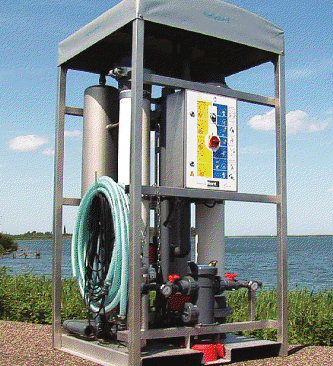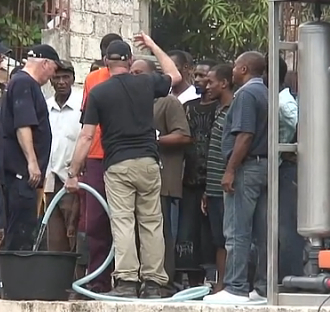Perfector-E
The Perfector-E is a self-contained portable water treatment system. It is originally developed for emergency aid purposes by PWN, Waterleidingbedrijf Noord-Holland, the Netherlands. However, it is also applicable as a permanent, decentralised, stand-alone water supplying unit. The Perfector-E is capable of treating any polluted surface water and providing high quality potable water. It is not designed for desalination, but it is a perfect pre-treatment for RO.
How it works
Surface water is supplied by a submerged pump via a coarse filter. Next, the water passes through a micro strainer. The main purification consists of two Norit X-Flow ultrafiltration membranes. The vertically positioned modules operate in dead-end mode and are cleaned by backwashing, removing the cake-layer formed during the dead-end filtration. The modules reduce the levels of pathogenic organisms such as parasites, bacteria, and viruses. As a further barrier, UV disinfection is included to the system. It uses Norit X-Flow elements in its membrane modules with permanent hydrophilic low-fouling UF membranes. The capacity is approx. 2.000 l/hour, using power supply of 230 Volts/3,1 kW or via supplied power generator (5kW). There are two operational pumps: feed pump of 2,5 m3/h and backwash pump of 12 m3/h. The dimensions are 1,1x1,1x2,2 meters.
Suitable conditions
The perfector-E should be kept at a maximum distance of 25 meters from a water source.
| Advantages | Disadvantages |
|---|---|
| - Produces high quality potable water - Operates without any chemicals |
- Need a power supply |
In addition to Perfector-E, there’s Perfector-O which is effective in treating heavily polluted water (Arsenic, TDS, Iron, Fluoride, and the like of it). The technology uses similar techniques with addition of RO adsorption and UV light radiation. Perfector-O provides high removal of As (III) and As (V). It does not introduce toxic residues.
|
|
Construction, operations and maintenance
System operation is based on plug and play, making it easy for users to operate.
The system is very robust and almost no maintenance is required even under harsh circumstances. For example, in many places in the tsunami affected area and also in Haiti 2010 the perfector-E was successfully used as a purification system. The machine does need to be cleaned, without moving it, every 3 months. This usually takes about 2 hours.
It comes complete with power generator or solar panels/wind mill to produce the required electricity and a pump with a floating hose to feed the unit with the polluted water. The system can be bought from the manufacturer or an option to rent the unit is available.
Estimated Lifespan
The membrane lifetime is 3-5 years depending on water source quality.
Costs
| Capital cost | Operating cost | Replacement cost | Estimated 5 year cost | Cost / metre cubed treated |
|---|---|---|---|---|
| ~US$ 42.000 = €30.000 | € 1450/year (electricity) + € 500/year (salary) * | 2,5 * € 300 | US$ 30 (estimated cost over 1 year) | € 0,69 |
Note: Assuming a lifetime of 5 years, 16 hours daily operation, meaning approximately 2.000 litres/day is processed, no membrane replacement is required. The UV lamp should be replaced every 2 years. The cost of one UV lamp is €300 (medium pressure; 9.000 hours). Operation cost is based on 16 hours per day * 3,1 kWh; electricity price in the Netherlands per kWh is €0,08. Hence, estimated annual electricity cost is €1450. Salary is assumed €500/year (fulltime); based on GNI per capita of least developed countries (World Bank).
Field experiences
The Perfector-E has been successfully applied and still in full operation in Indonesia, India, Pakistan, Peru, Soudan, Rwanda, Angola, Romania, Benin, south Africa, Egypt, Sudan, Kenya, Nepal, Philippines, Congo and China.


